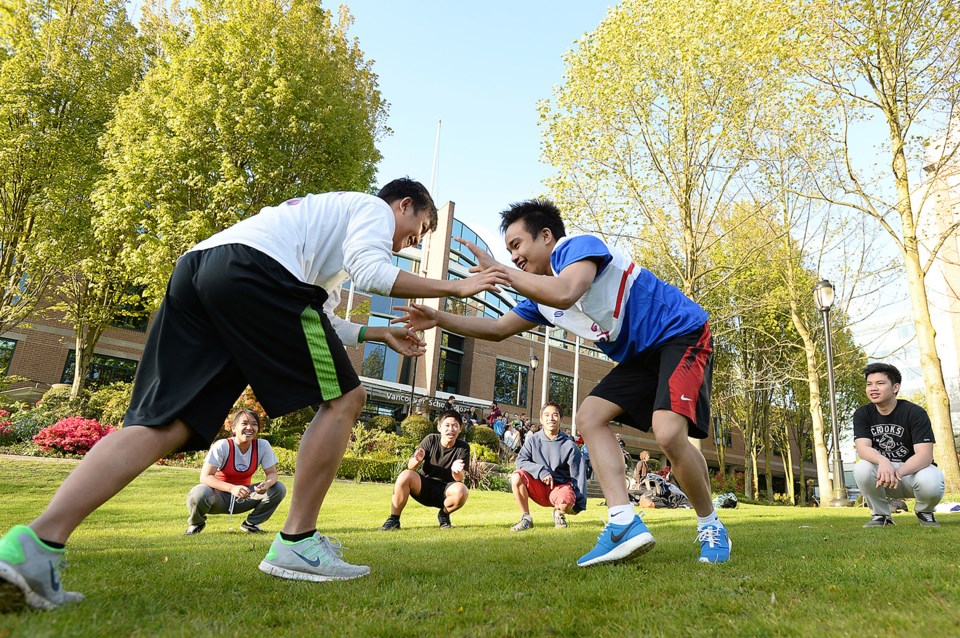The Vancouver School Board saves at least $2 million in coaching and sports administration costs because of volunteers who say they cannot run hundreds of sports teams during three competitive seasons without the central administrative support of a district-wide athletic coordinator.
This was the argument made by teachers, coaches, parents, an Olympian, a Toronto Blue Jays assistant manager and several student-athletes who pleaded with the VSB not to eliminate the position of the athletic coordinator at a final hearing Monday evening.
School board trustees decide Wednesday how they will cut $11.65 million from the 2014-15 budget to make up for a funding shortfall. In 12 years, the VSB has had to chop $47 million from public school education because of decreasing government funding and declining enrolment.
One trustee asked VSB staff how leagues would operate without a central and impartial coordinator. A staff member said the work would likely fall to teachers, coaches and administrators. This, she said, “would lead to less consistency and opportunity for kids.”
By cutting the athletics coordinator, a CUPE position, the VSB will save $72,000. The cost is too great, advocates argued, and several put forward numbers of their own.
The $2 million in savings is the estimate of Kathleen Shiels, a single mother who homeschooled her son after he suffered a traumatic brain injury. It was sport, volleyball specifically, that helped him integrate back into high school alongside his peers.
Shiels calculated that each public school coach puts in eight hours a week of volunteer time to run a team. These hours increase during playoffs, time which is over and above the eight hours per week. The fall, winter and spring sports seasons run for 12 weeks, she argued, and at least 2,000 coaches volunteer to run 1,500 teams at elementary and secondary schools. If those volunteers, including teachers and community coaches, were paid minimum wage, the VSB would be on the hook for at least $1.9 million.
The calculation stumbles on two figures. High school seasons are 12 weeks long at most for teams that advance all the way to B.C. championships but some teams’ seasons will end after six weeks. But since the eight hours each week is a low estimate, the higher number of weeks lends some balance.
The estimate of 1,500 teams is also at the high end. Vancouver high schools have roughly between 25 and 40 teams. Kitsilano had 53 teams this year and University Hill, with by far the lowest sports participation, had fewer than 10 teams. The city’s 109 public elementary schools typically have basketball and volleyball teams and also run track and cross-country.
If every elementary school has six teams, that’s more than 650 teams. With 680 high school teams, that brings us to more than 1,300 teams. That figure alone is incredible to consider.
In regards to the tally of 2,000 coaches, many teachers will coach numerous sports, and since each season stands on its own in these calculations, it’s correct that teachers be counted once for every season they coach. If every team has two coaches — some high school teams have three in addition to a sponsor — now we’re talking a very high number of volunteers each season.
The VSB could not provide me with an exact number of current student-athletes or the number of teachers who volunteer to either coach or sponsor a team this year.
The VSB also heard personal examples of the value of sport.
Candy Thomson was never picked first but since elementary school tried out for every team. “I was always the fifth person on the four-person relay,” she said. Undeterred, Thomson knew she’d discovered her passion and told the trustees how sport eventually took her around the world with the women’s national field hockey team.
“High school sports shape you into the type of person you will be for the rest of your life,” said Markiel Simpson, a Van Tech graduate who plays varsity volleyball at university. He pointed to another alum, Ken Li, who founded Apex Volleyball which is now one of the most influential volleyball clubs in the city.
Here’s another calculation to consider. If an average of 18 student-athletes compete on roughly 35 teams at 18 high schools, that’s 21,000 teenagers in Grades 8 through 12. This equals roughly 7,000 student-athletes per seasons since some will play multiple sports, meaning one season an athlete could be a swimmer and the next a shooting guard.
Larry Cruickshank, a father whose son plays basketball at Churchill secondary, crunched these numbers, too. He said the $72,000 saved by eliminating the district-wide athletic coordinator breaks down to a dollar amount for every teen who competes for his public high school team.
“View it as an investment of $3.50 per athlete. There is no doubt that the availability of sports within school keeps a number of students in school,” he said.
“The lynchpin to all of this is the district athletic coordinator.”
Without an administrator in the role, he said, “that will invariably lead to the disintegration of the whole system.”



